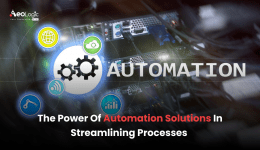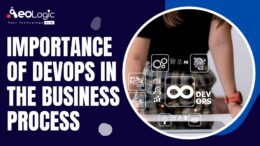The internet of things (IoT) digitizes physical assets of sensors, devices, machines, gateways, and the network. It connects people to things and things to things in real-time. A typical internet of things (IoT) network can grow rapidly, resulting in exponential growth in the variety, velocity, and overall volume of data. In this blog, you’ll get to know how IoT in your business will be highly beneficial.
So let’s get started!
A Brief About Internet of Things (IoT)
The Internet of things is the device that collects the data from sensors and transmits the data through the internet. One of the best ways to start understanding the IoT in your business is to think of it as adding intelligence to the workflow where the previously wasn’t any.
By enabling IoT in your business you can now inexpensively embed sensors and radios into products such as lighting fixtures, kitchen appliances, or bicycles and many more can be taken down as an example.
The idea behind this is to enable these things to communicate with other devices or smartphones or simply send collected information into the cloud. Hence, this data opens opportunities for significant value creation and revenue generation.
What Is The Need Of Having IoT In Your Business?
In today’s modern era where everything is getting digitized and customers’ expectations are getting higher and higher, businesses are focusing more on gathering real-time data. In order to achieve desired business objectives, and grow exponentially, it requires the ability to act in real-time to take advantage of opportunities and address problems quickly.
During the pre-internet of things (IoT) era, an issue in a typical supply chain scenario could be addressed in a two to three days cycle for satisfactory results. But with the implementation of the internet of things (IoT) in your business, the time to act is in minutes, seconds, or in microseconds. 30 minutes to provision electric service, 30 seconds to act on information from devices, and 5 microseconds to address a security breach.
The Internet of things (IoT) environment means the value of data will slip away quickly. The importance of time to act for the internet of things applications could be seen in a wide range of applications and use cases.
Broadly speaking, these applications can be grouped into three categories:
- Operations at fulfillment are a convenient place to prove the efficiency gains.
- Customer-focused sales and marketing applications have the potential to increase customer satisfaction and long-term growth.
- Innovation in new products and services can drive new revenue and business value.
There are also specific use cases within these applications; predictive maintenance, demand and supply optimization, predictive one-to-one marketing, and outrage management.
Addressing the critical time to action requirement for these use cases and applications. Internet of things (IoT) demands an advanced analytics solution that unifies historical real-time streaming predictive, prescriptive, and faster analytics and provides smarter actions.
Why Does IoT In Your Business Matter?
In today’s modern era, implementing IoT in your business means that capturing and utilizing the data will be optimized. In business, data analytics is undoubtedly very essential. The quality of analyzing the information will determine the success of your business.
A great example of the benefits of connecting your product to the internet of things (IoT) can be found in the healthcare industry. In healthcare, the use of smart pill bottles are started to be used, and it issues notifications when the medication is to be taken. It alerts the patient and healthcare providers when a dose has been missed, and it stores data in the cloud that protects the privacy of the patients. But over time provides important information about medication adherence to healthcare providers and pharmaceutical companies.
Ecosystem Of IoT In Your Business
The complexity of the IoT combined with the high expectation are created by the internet, mobile, and 24/7 IT environment. This indeed has made the need for new analytics approaches and technologies more urgent.
Four distinct components of an integrated IoT system are as follows:
- Sensors
Internet of things (IoT) sensors collects data from the devices. For example, in industrial factories, the sensor works to gather various data. This data is generated from the temperature, velocity, pressure, and expansion of steel.
- Connectivity
All the gathered data will be transferred to the highly-secured cloud via the internet. There are a variety of devices to transfer the data, it can be cellular, satellite, Wi-Fi, or even Ethernet devices. - Cloud
This is the third step, machine learning takes the role in the process where the software integrates and processed the data by implementing analytics. Analytics enables to share of insights and information on certain needs.
Also, give read of our blog: “The Role of AI and Machine Learning in Revolutionizing Clinical Research” - User Interface
In the last step, the users can remotely log in to the systems through an interface dashboard that is built for specific needs. The user may be able to perform an action that can improve your business performance. From increasing productivity, reducing operation costs, or expanding into new markets.
Conclusion:
To sum up, the implementation of IoT in your business will increase the efficiency and productivity of operations. IoT enables transmitting real-time information with high accuracy, leading to generating effective insights. This gives the business to optimize their performance as well it gives a competitive advantage in the market too.
Are you looking to implement the internet of things (IoT) in your business? If yes, so, please feel free to contact us at support@aeologic.com






